Eusergestes similis (Hansen, 1903)Common name(s): Pacific sergestid |
|
| Synonyms: Sergestes similis | 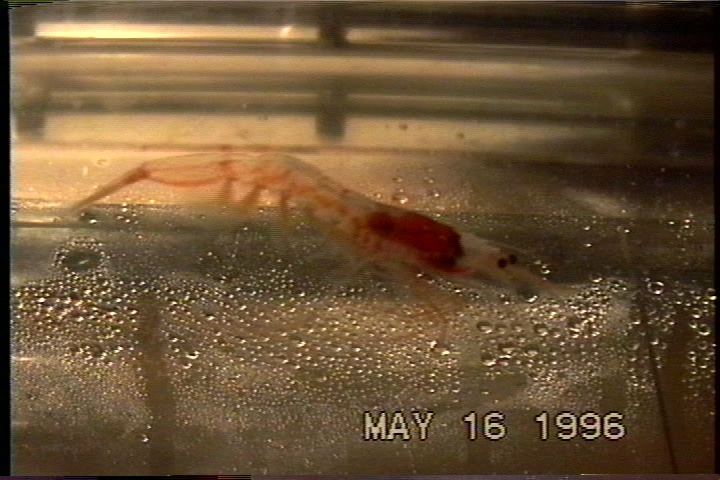 |
| Phylum Arthropoda
Subphylum Crustacea Class Malacostraca Subclass Eumalacostraca Superorder Eucarida Order Decapoda "Natantia" (shrimp--not a formal taxonomic category) Suborder Dendrobranchiata Family Sergestidae |
|
| Eusergestes similis, captured off Point Conception, CA May 1996. Photographed live swimming in a swim tunnel. Total length approximately 6 cm. | |
| (Photo by: Dave Cowles, May 1996) | |
How to Distinguish from Similar Species: The only other sergestid common in this area, Sergia tenuiremis, has no supraorbital or hepatic spine, no Organ of Pesta, is not bioluminescent, and has a tubercle on the inner margin of the eyestalk.
Geographical Range: North Pacific Ocean, Japan through Alaska and the southwest Bering Sea south along the Amereican coast to the Gulf of California; off Chile, and in the eastern South Atlantic.
Depth Range: Surface (at night) to 1200 m; most common 150-500 m during the day (vertical migrator)
Habitat: Mesopelagic, Oceanic (offshore). Also found nearer shore in deeper areas of the continental shelf.
Biology/Natural History: Since red light does not penetrate to the daytime depths of this prawn, the red parts of its body are effectively black. This species has organs of Pesta, which are bioluminescent, ventral to the red visceral mass. The organs of pesta have a shiny reflector to make the bioluminescence directional. As the animal moves through the water it turns the organs of pesta so that the bioluminescence is directed downward, thus effectively erasing its shadow. In situ studies in Monterey Bay showed that this species swims an average of 7.4 cm/s, or about 1.5 body lengths per second. Propulsion is exclusively by the pleopods, which beat at 4 Hz. The animal swims continuously, and remains above the oxygen minimum layer. It ascends near the surface at night and descends to deeper water during the day. The antennae respond to tactile stimuli and probably to vibrations in the water. This species matures in 1 or 2 years. Peak spawning is during the summer. May die after spawning. Feeds on large copepods and euphausiids. Predators include albacore, rockfish, sei and fin whales, and snipe eels.
| Return to: | |||
| Main Page | Alphabetic Index | Systematic Index | Glossary |
References:
Dichotomous Keys:Kozloff 1987, 1996
Wicksten, 2009
Word, Jack and Danuta Charwat, 1974. Key to Shrimp Common in Southern California Trawl Catches. Southern California Coaster Water Research Project. 41 pp.
General References:
Butler,
1980
Scientific Articles:
Barham, E.G., 1956. The ecology of sonic scattering layers in
the Monterey Bay area. Ph.D. Dissertation, Stanford
University, Palo
Alto, CA
Childress, J.J., 1975. The respiratory rates of midwater crustaceans as a function of depth of occurrence and relation to the oxygen minimum layer off southern California. Comp. Biochem. Physiol. A Comp. Physiol. 50: 787-799
Childress, J.J. and M. Nygaard, 1974. Chemical composition and buoyancy of midwater crustaceans as a function of depth of occurrence off southern California. Marine Biology 27: 225-238
Cowles, David L., 1994. Swimming dynamics of the mesopelagic vertically migrating penaeid shrimp Sergestes similis: Modes and speeds of swimming. Journal of Crustacean Biology 14(2): 247-257
Cowles, David L., 2001. Swimming speed and metabolic rate during routine swimming and simulated diel vertical megration of Sergestes similis in the laboratory. Pacific Science 55(3): 215-226
Genthe, H.C., Jr., 1969. The reproductive biology of Sergestes similis (Decapoda: Natantia). Marine Biology 2: 203-217
Hendrickx, Michel E. and Estrada Navarrete, Flor Delia, 1996. Los Camarones Pelagicos (Crustacea: Dendrobranchiata y Caridea) del Pacifico Mexicano. Comision Nacional para el Conocimiento y Uso de la Biodiversidad. 157 pp.
Omori, M., 1979. Growth, feeding, and mortality of larval and early postlarval stages of the oceanic shrimp Sergestes similis Hansen. Limnology and Oceanography 24: 273-288
Omori, M. and D. Gluck, 1979. Life history and vertical migration of the pelagic shrimp Sergestes similis off the southern California coast. Fish. Bull. 77: 183-198
Pearcy, W.G. and C.A. Forss, 1966. Depth distribution of oceanic shrimps (Decapoda: Natantia) off Oregon. Journal of the Fisheries Research Board of Canada 23: 1135-1143
Pearcy, W.G. and C.A. Forss, 1969. The oceanic shrimp Sergestes similis off the Oregon coast. Limnology and Oceanography 14: 755-765
Web sites:
General Notes and Observations: Locations, abundances, unusual behaviors:
This species is abundant off our Pacific coast, and is often the dominant mesopelagic vertical migrating shrimp in our region.
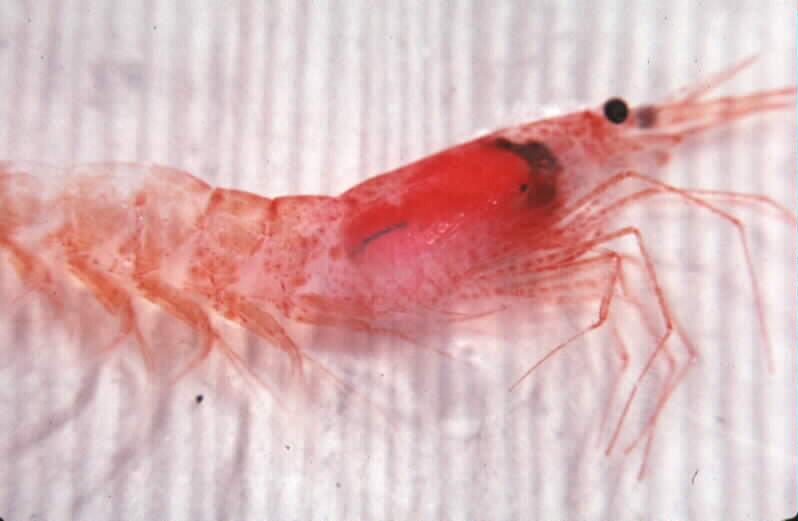
Most of this species' body is transparent, with small red chromatophore
spots. The internal thoracic organs are opaque red or
black.
The organs of Pesta (not readily visible in this photo) are ventral to
the dark thoracic organs. Note the tiny rostrum
(the small red dorsal bump behind the eyes). The long second
antennae
trail out to the right of this photo. Swimming is almost
exclusively
by the pleopods.
Photo by Dave Cowles
For an .mpg video of this species swimming in a swim tunnel, click Here (8 megabytes). Note in the video (and in the image at the top of this page, which was taken from the video), that the animal turns downward when exposed to the light of the camera. This is because it is a vertical migrator.
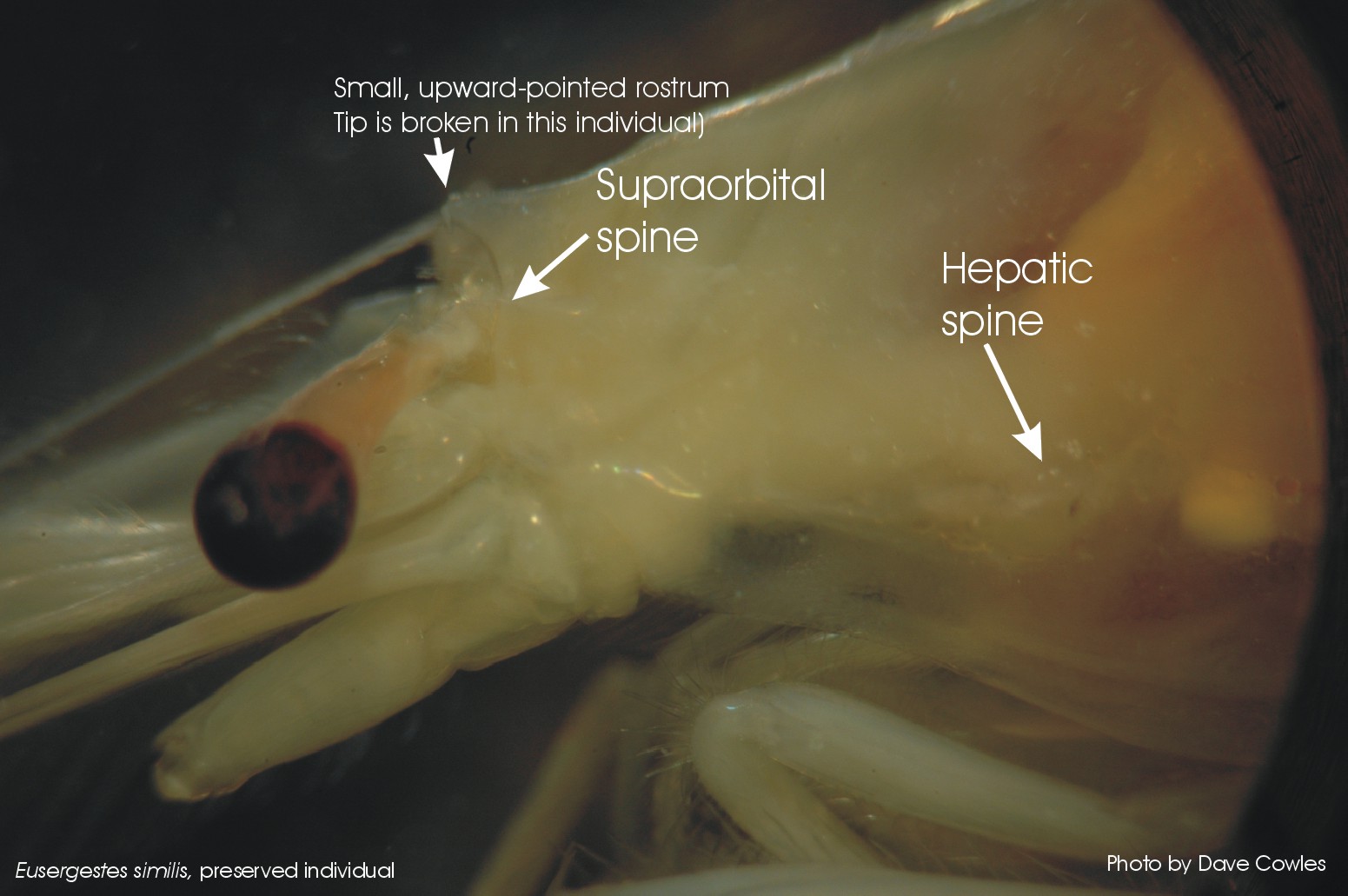
Eusergestes similis can be distinguished from Sergia
tenuiremis by the small, acute, upward-pointed rostrum
and by the presence of a supraorbital
and a hepatic
spine.
This photo is of a preserved individual.
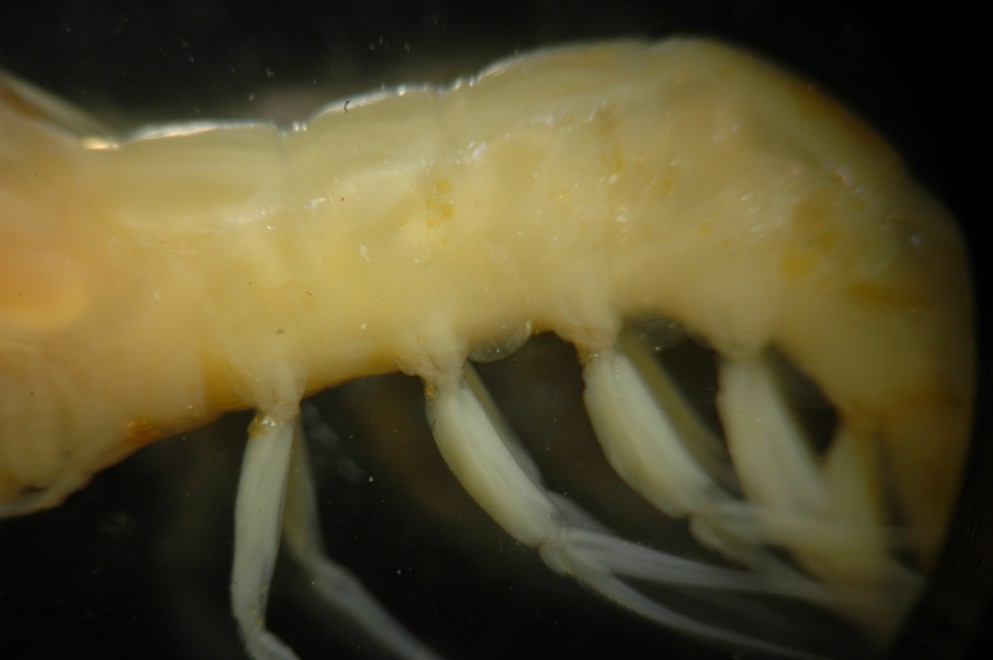
The epimera
of abdominal segment 2 does not overlap those of segments 1 and 3,
showing
this species is not a Caridean shrimp.
Photo from a preserved specimen
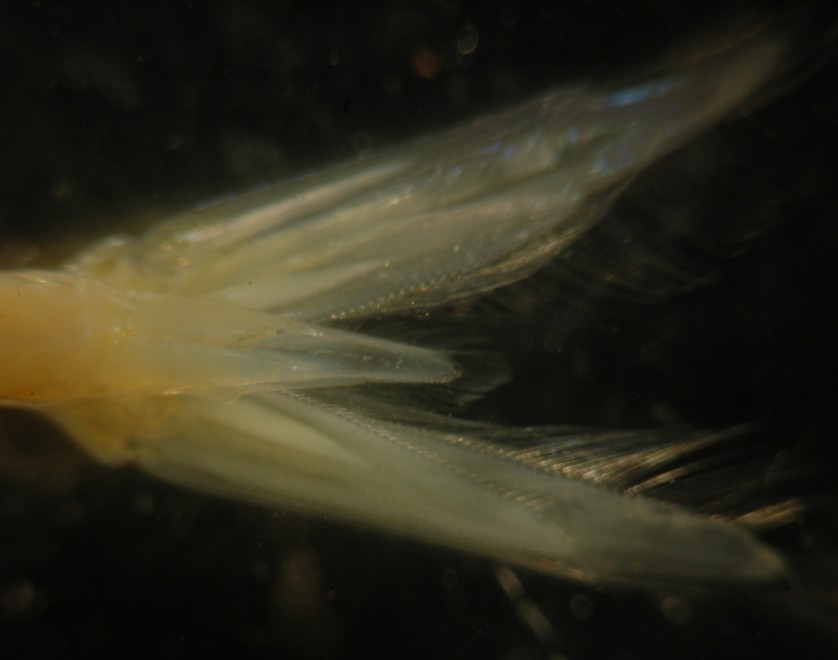
The telson
is shorter than the uropods,
and both telson
and uropods
are fringed with setae.
Photo from a preserved specimen
Authors and Editors of Page:
Dave Cowles (2006): Created original page